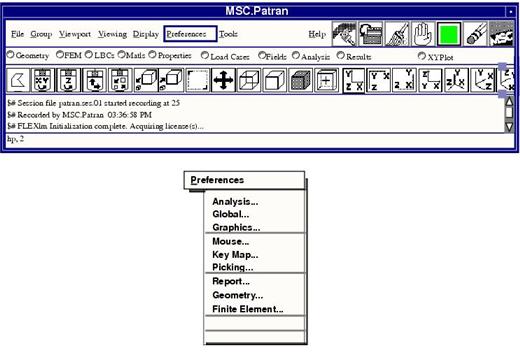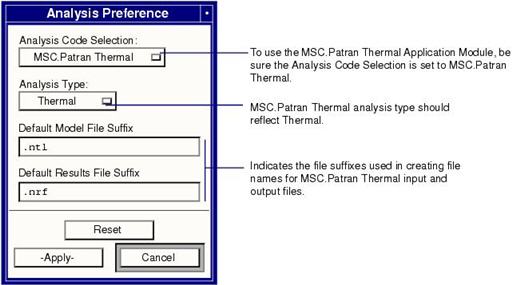XXXXXXXXXXXXXXXXXXXXXXXXXXXXXXXXXXXXXXXXXXXXXXXXXXXXXXXXXXXXXXXXXXXXXXXXXXXXXXXXXXXXXXXXXXXXXXXXXXXXXXXXXXXXXXXXXXXXXXXXXXXXXXXXXXXXXXXXXXXXXXXXXXXXXXXX''"> Introduction to Building a Model
There are many aspects to building a finite element analysis model. In several cases, the forms used to create the finite element data are dependent on the selected analysis code and analysis type. Other parts of the model are created using standard forms.
Under Preferences, on the Patran main form, is a selection for Analysis. Analysis Settings defines the intended analysis code which is to be used for this model.
The Analysis Code Selection may be changed at any time during model creation. As much data as possible will be converted if the analysis code is changed, after the modeling process has already begun. The setting of this option defines what will be presented to the user, in several areas, during the subsequent modeling steps. For more details, see
Analysis Form (Ch. 5) in the Patran Thermal User’s Guide Volume 1: Thermal/Hydraulic Analysis.
Overall Analysis Structure
Patran Thermal produces files that are compatible with the P/THERMAL solver. This includes a neutral file, the analysis control files qin.dat and vf.ctl, and the script for executing the model patq.inp. The script can be executed locally from within Patran, producing the input data files and invoking the solver. Alternately, the files may be moved to a different platform where P/THERMAL resides for execution. With P/THERMAL, multiple jobs can be created from the same Patran database. The model files will appear in subdirectories named with the jobname that was entered in the Analysis form.
For a model whose boundary conditions do not point to a template ID and which references a material in the P/THERMAL materials library (971-members), Patran Thermal can create the model, submit it for execution, and postprocess results directly from Patran, without having to invoke the text editor. In general, the user will only have to utilize the text editor if the model has time/temperature dependent BCs, view factors, or require user subroutines.
Material Definition
In this release of Patran Thermal, materials must be specified as a number (e.g., 18 or m:18) or by a name (e.g., steel). The materials set is created when the number or name is entered in the Element Properties form. The material number refers to a material ID in the
template.dat file. If a definition is not found in the local template corresponding to the material number and the material number is in the range 1 to 971, P/THERMAL will use the MID Template delivered with the solver and load the temperature dependent material properties. The material IDs associated with the database delivered with the module can be found in
Mid Templates Supplied in Templatebin and Templatetxt (App. B) in the Patran Thermal User’s Guide Volume 1: Thermal/Hydraulic Analysis.
If a material is specified in the element properties form by a name, the names are added to the Material Sets and will be numbered at translation time sequentially in the order they were created. For example, if the materials set created by defining materials under Element Properties are given the names Zirconium, Steel and Carbon-Felt, they will be assigned MID numbers 1, 2 and 3, respectively. These MIDs must be further defined in the MID Template since these materials do not correspond to the MID templates supplied with the module.
Important: | Do not mix material names and material numbers. |


